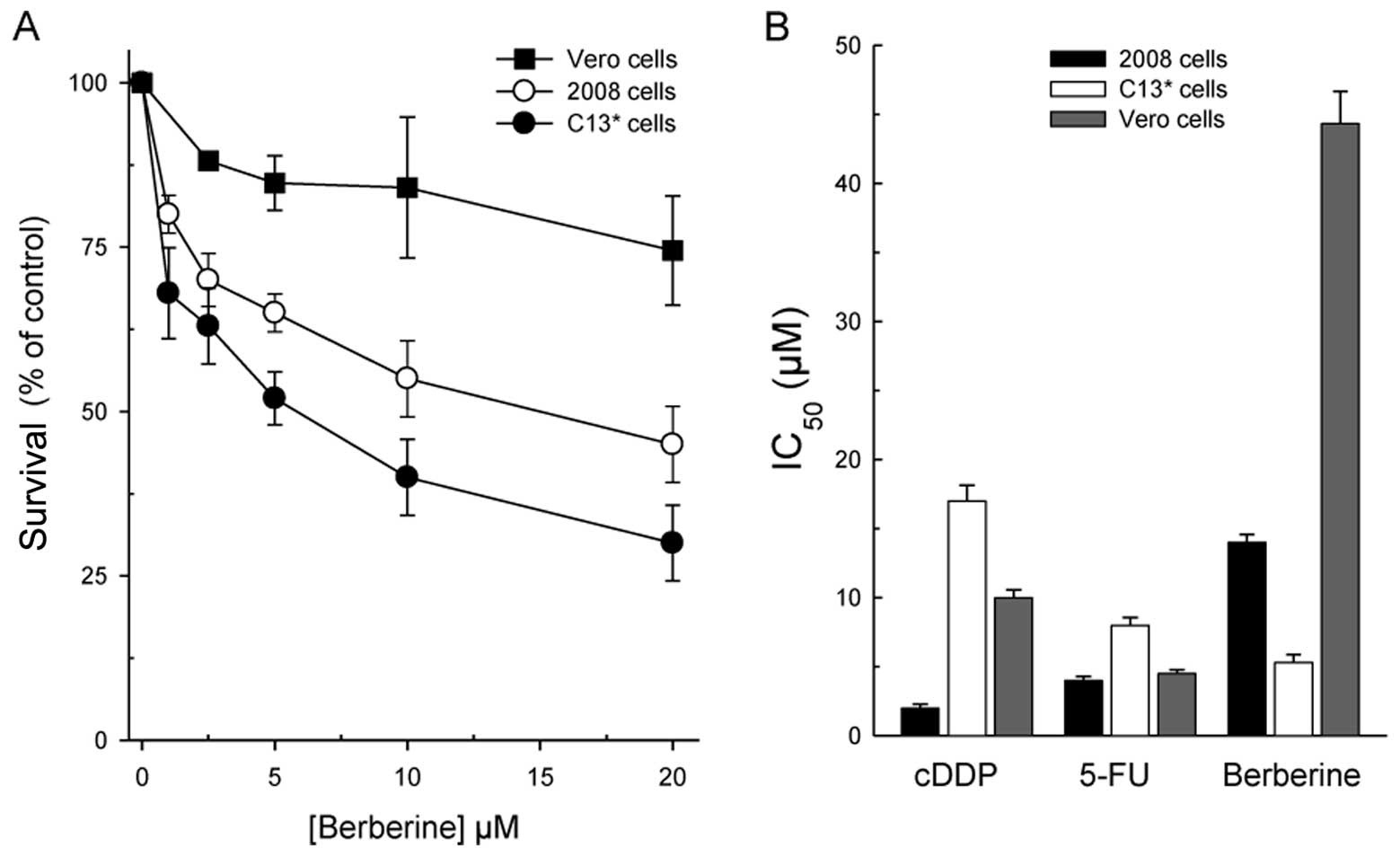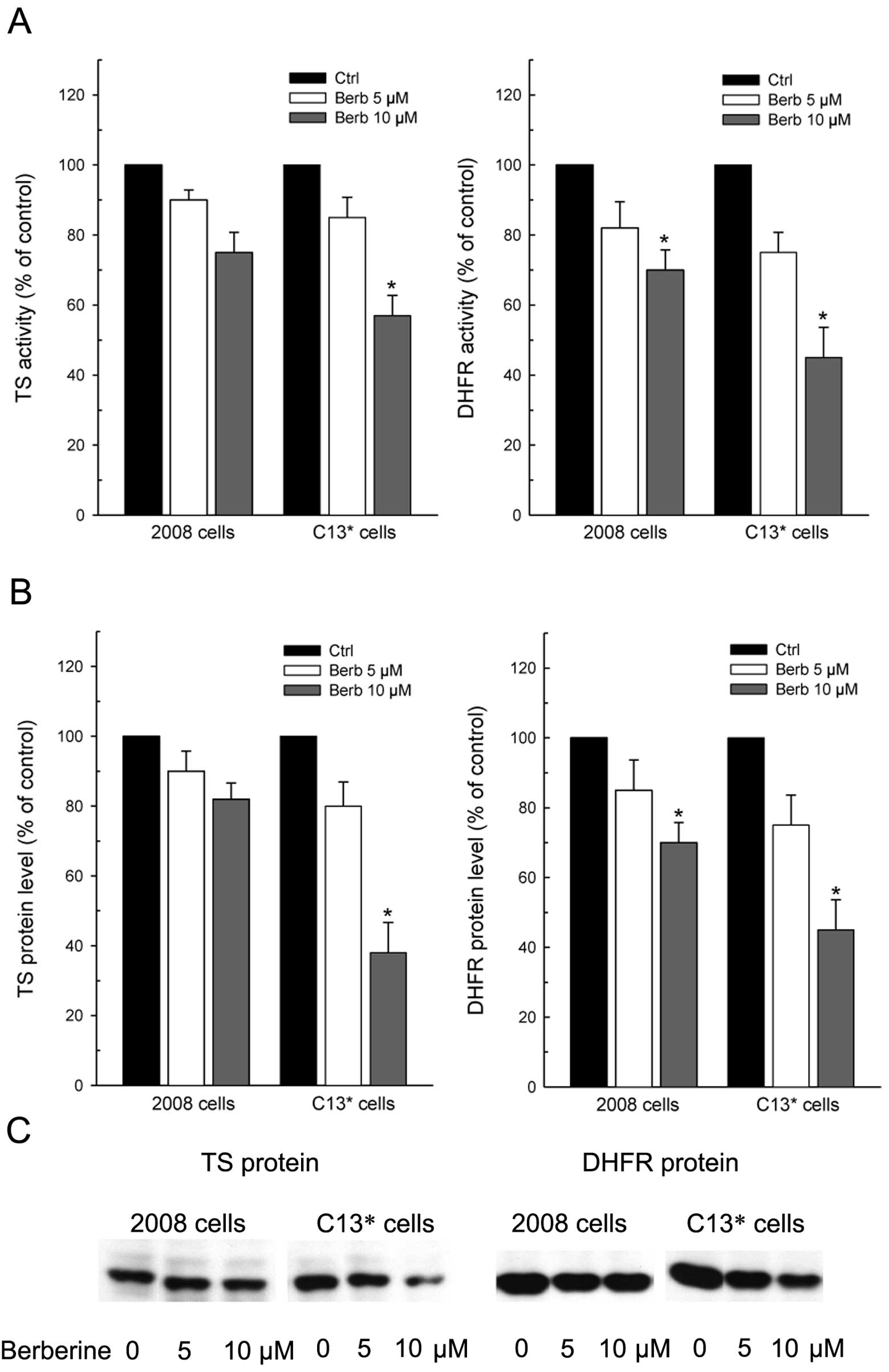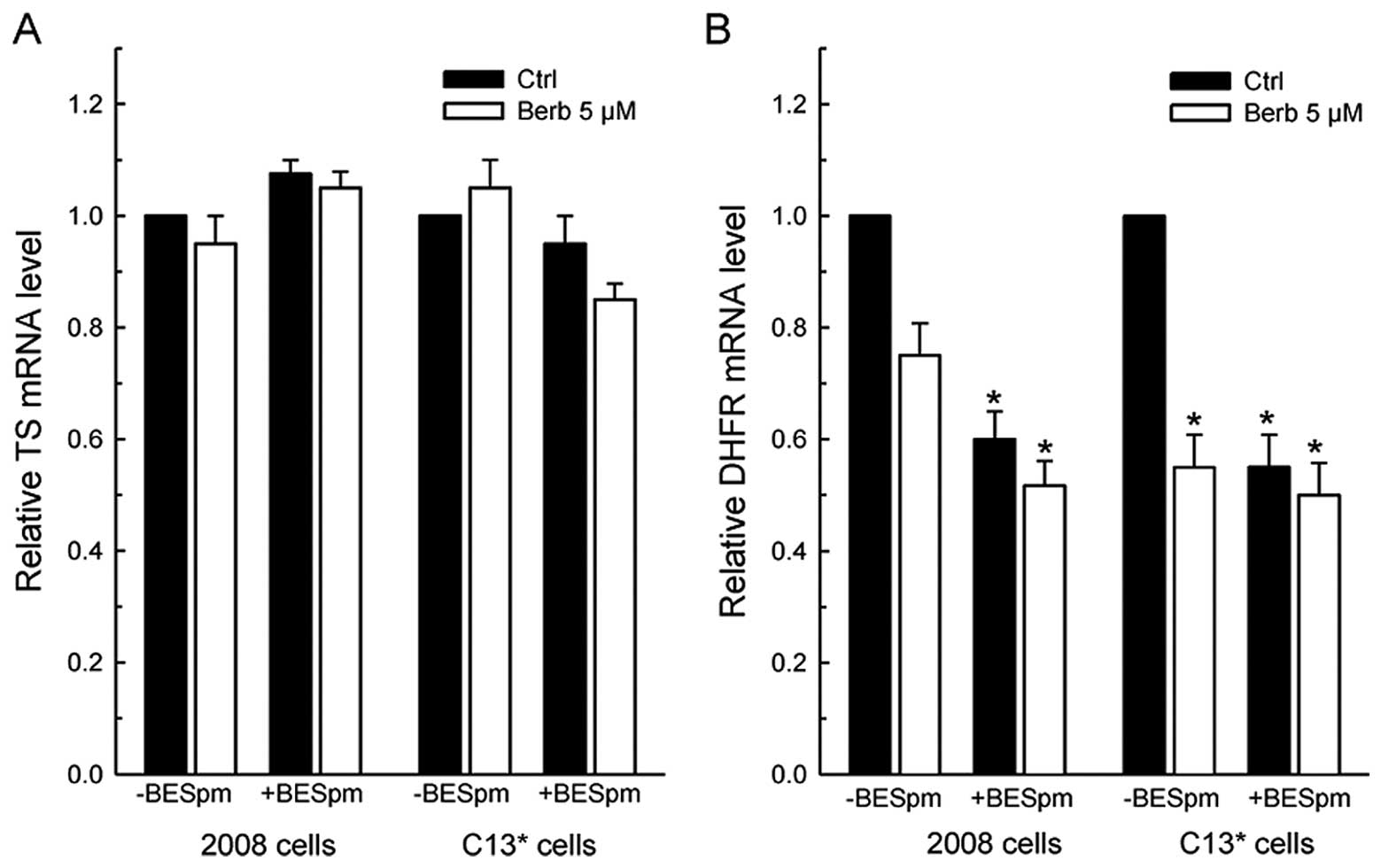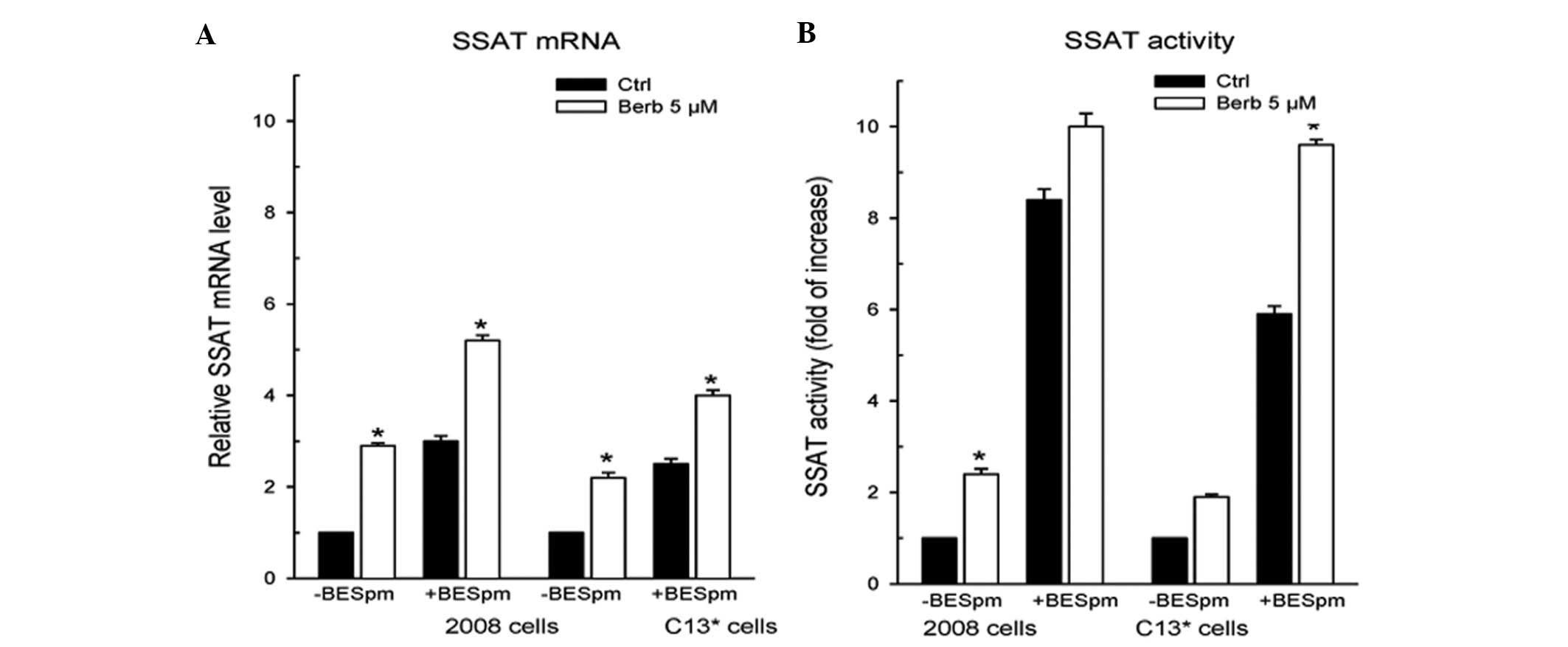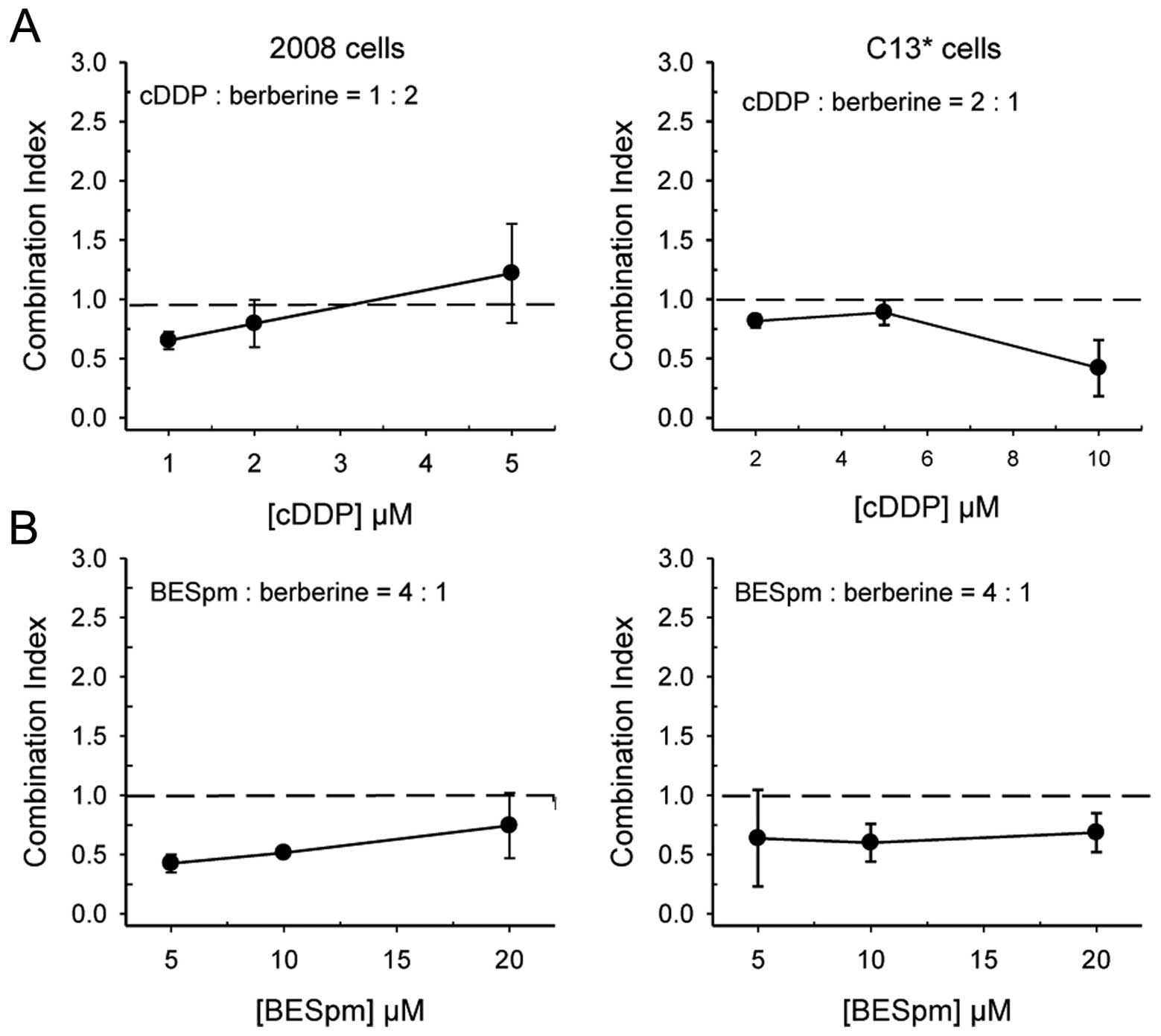|
1.
|
Ozols RF, Bookman MA, Connolly DC, et al:
Focus on 433 epithelial ovarian cancer. Cancer Cell. 5:19–24. 2004.
View Article : Google Scholar
|
|
2.
|
Muggia F: Platinum compounds 30 years
after the introduction of cisplatin: implications for the treatment
of ovarian cancer. Gynecol Oncol. 112:275–281. 2009.PubMed/NCBI
|
|
3.
|
Jakubowicz-Gil J, Paduch R, Piersual T,
Glowniak K, Gawron A and Kandefer M: The effect of quercetin on
pro-apoptotic activity of cisplatin in HeLa cells. Biochem
Pharmacol. 6:1343–1350. 2005. View Article : Google Scholar : PubMed/NCBI
|
|
4.
|
Maeda H, Hori S, Ohizumi H, Segawa T,
Kakehi Y, Ogawa O and Kakizuka A: Effective treatment of advanced
solid tumors by the combination of arsenic trioxide and
L-buthionine-sulfoximine. Cell Death Differ. 11:737–746. 2004.
View Article : Google Scholar : PubMed/NCBI
|
|
5.
|
Umanzor J and Aguiluz M: Concurrent
cisplatin/gemcitabine chemotherapy along with radiotherapy in
locally advanced cervical carcinoma: a phase II trial. Gynecol
Oncol. 100:70–75. 2006. View Article : Google Scholar : PubMed/NCBI
|
|
6.
|
Scanlon KJ and Kashani-Sabet M: Elevated
expression of thymidylate synthase cycle genes in
cisplatin-resistant human ovarian carcinoma A2780 cells. Proc Natl
Acad Sci USA. 85:650–653. 1988. View Article : Google Scholar : PubMed/NCBI
|
|
7.
|
Wysocki PJ: Targeted therapy of
hepatocellular cancer. Expert Opin Investig Drugs. 19:265–274.
2010. View Article : Google Scholar : PubMed/NCBI
|
|
8.
|
Lin CC, Yang JS, Chen JT, et al: Berberine
induces apoptosis in human HSC-3 oral cancer cells via simultaneous
activation of the death receptor-mediated and mitochondrial
pathway. Anticancer Res. 27:3371–3378. 2007.PubMed/NCBI
|
|
9.
|
Mantena SK, Sharma SD and Katiyar SK:
Berberine, a natural product, induces G1-phase cell cycle arrest
and caspase-3-dependent apoptosis in human prostate carcinoma
cells. Mol Cancer Ther. 5:296–308. 2006. View Article : Google Scholar : PubMed/NCBI
|
|
10.
|
Yoon MJ, So HS, Cho HJ, et al: Berberine,
a natural product, combined with cisplatin enhanced apoptosis
through a mitochondria/caspase-mediated pathway in HeLa cells. Biol
Pharm Bull. 31:789–795. 2008. View Article : Google Scholar : PubMed/NCBI
|
|
11.
|
Yi ZB, Yan Y, Liang YZ, et al: Evaluation
of the antimicrobial mode of berberine by LC/ESI-MS combined with
principal component analysis. J Pharm Biomed Anal. 44:301–304.
2007. View Article : Google Scholar : PubMed/NCBI
|
|
12.
|
Liu JC, Chan P, Chen YJ, et al: The
antihypertensive effect of the berberine derivative
6-protoberberine in spontaneously hypertensive rats. Pharmacology.
59:283–289. 1999. View Article : Google Scholar : PubMed/NCBI
|
|
13.
|
Kuo CL, Chi CW and Liu TY: The
anti-inflammatory potential of berberine in vitro and in vivo.
Cancer Lett. 203:127–137. 2004. View Article : Google Scholar : PubMed/NCBI
|
|
14.
|
Un Y, Xun K, Wang Y, et al: A systematic
review of the anti-cancer properties of berberine, a natural
product from Chinese herbs. Anticancer Drugs. 20:757–769. 2009.
View Article : Google Scholar : PubMed/NCBI
|
|
15.
|
Tang J, Feng Y, Tsao S, et al: Berberine
and Coptidis rhizoma as novel antineoplastic agents: a
review of traditional use and biomedical investigations. J
Ethnopharmacol. 126:5172009.
|
|
16.
|
Kong B, Huang S, Wang W, May D, et al:
Arsenic trioxide induces apoptosis in cisplatin-sensitive and
-resistant ovarian cancer cell lines. Int J Gynecol Cancer.
15:872–877. 2005. View Article : Google Scholar : PubMed/NCBI
|
|
17.
|
Lin JP, Yang JS, Lee JH, Hsieh WT and
Chung JG: Berberine induces cell cycle arrest and apoptosis in
human gastric carcinoma SNU-5 cell line. World J Gastroenterol.
12:21–28. 2006.PubMed/NCBI
|
|
18.
|
Halestrap AP, Doran E, Gillespie JP and
O’Toole A: Mitochondria and cell death. Biochem Soc Trans.
28:170–171. 2000.
|
|
19.
|
Duverger V, Sartorius U,
Klein-Bauernschmitt P, Krammer PH and Schlehofer JR: Enhancement of
cisplatin-induced apoptosis by infection with adeno-associated
virus type 2. Int J Cancer. 97:706–712. 2002. View Article : Google Scholar : PubMed/NCBI
|
|
20.
|
Li JJ, Tang Q, Li Y, Hu BR, Ming ZY, Fu Q,
Qian JQ and Xiang JZ: Role of oxidative stress in the apoptosis of
hepatocellular carcinoma induced by combination of arsenic trioxide
and ascorbic acid. Acta Pharmacol Sin. 27:1078–1084. 2006.
View Article : Google Scholar : PubMed/NCBI
|
|
21.
|
Jantova S, Cipak L and Letasiova S:
Berberine induces apoptosis through a mitochondrial/caspase pathway
in human promonocytic U937 cells. Toxicol In Vitro. 21:25–31. 2007.
View Article : Google Scholar : PubMed/NCBI
|
|
22.
|
Marverti G, Guaitoli G, Ligabue A,
Frassineti C, Monti MG, Lombardi P and Costi MP: Distamycin A and
derivatives as synergic drugs in cisplatin-sensitive and -resistant
ovarian cancer cells. Amino Acids. 42:641–653. 2012. View Article : Google Scholar : PubMed/NCBI
|
|
23.
|
Arcamone F, Pencos PG, Orezzi PG,
Nicolella V and Pirelli AM: Structure and synthesis of distamycin
A. Nature. 203:1064–1065. 1964. View Article : Google Scholar : PubMed/NCBI
|
|
24.
|
Abu-Daya A and Fox KR: Interaction of
minor groove binding ligands with long AT tracts. Nucleic Acids
Res. 25:4962–4969. 1997. View Article : Google Scholar : PubMed/NCBI
|
|
25.
|
Carreras CW and Santi DV: The catalytic
mechanism and structure of thymidylate synthase. Annu Rev Biochem.
64:721–762. 1995. View Article : Google Scholar : PubMed/NCBI
|
|
26.
|
Costi P and Ferrari S: Update on
antifolate drugs targets. Curr Drug Targets. 2:135–166. 2001.
View Article : Google Scholar : PubMed/NCBI
|
|
27.
|
Choi W, Gerner EW, Ramdas L, et al:
Combination of 5-fluorouracil and N1,N11-Diethylnorspermine
markedly activates spermidine/spermine N1-acetyltransferase
expression, depletes polyamines and synergistically induces
apoptosis in colon carcinoma cells. J Biol Chem. 280:3295–3304.
2005. View Article : Google Scholar
|
|
28.
|
Allen WL, McLean EG, Boyer J, et al: The
role of spermidine/spermine N1-acetyltransferase in determining
response to chemotherapeutic agents in colorectal cancer cells. Mol
Cancer Ther. 6:128–137. 2007. View Article : Google Scholar : PubMed/NCBI
|
|
29.
|
Marverti G, Ligabue A, Guerrieri D, et al:
Spermidine/spermine N1-acetyltranferase modulation by novel folate
cycle inhibitors in cisplatin-sensitive and -resistant human
ovarian cancer cell lines. Gynecol Oncol. 117:202–210. 2010.
View Article : Google Scholar
|
|
30.
|
Wallace HM and Niiranen K: Polyamine
analogues - an update. Amino Acids. 33:261–265. 2007. View Article : Google Scholar : PubMed/NCBI
|
|
31.
|
Wallace HM and Fraser AV: Inhibitors of
polyamine metabolism: review article. Amino Acids. 26:353–365.
2004. View Article : Google Scholar : PubMed/NCBI
|
|
32.
|
Marverti G, Monti MG, Pegg AE, et al:
Spermidine/spermine N1-acetyltransferase transient over-expression
restores sensitivity of resistant human ovarian cancer cells to
N1,N12-bis(ethyl)spermine and to cisplatin. Carcinogenesis.
26:1677–1686. 2005. View Article : Google Scholar
|
|
33.
|
Andrews PA, Murphy MP and Howell SB:
Differential potentiation of alkylating and platinating agent
cytotoxicity in human ovarian carcinoma cells by glutathione
depletion. Cancer Res. 45:6250–6253. 1985.PubMed/NCBI
|
|
34.
|
Rossi T, Coppi A, Bruni E, Ruberto A,
Santachiara S and Baggio G: Effects of anti-malarial drugs on MCF-7
and Vero cell replication. Anticancer Res. 27:2555–2560.
2007.PubMed/NCBI
|
|
35.
|
Lowry OH, Rosebrough NJ, Farr AL and
Randall RJ: Protein measurement with the Folic phenol reagent. J
Biol Chem. 193:265–275. 1951.PubMed/NCBI
|
|
36.
|
Kueng W, Siber E and Eppenberger U:
Quantification of cells cultured on 96-well plates. Anal Biochem.
182:16–19. 1989. View Article : Google Scholar : PubMed/NCBI
|
|
37.
|
van Triest B, Pinedo HM, van Hensbergen Y,
et al: Thymidylate synthase level as the main predictive parameter
for sensitivity to 5-fluorouracil, but not for folate-based
thymidilate synthase inhibitors, in 13 nonselected colon cancer
cell lines. Clin Cancer Res. 5:643–654. 1999.
|
|
38.
|
Rothenberg SP, Perwaiz Iqbal M and Da
Costa M: A simplified radioenzymatic assay for dihydrofolate
reductase using [3H]dihydrofolate. Anal Biochem.
103:152–156. 1980.PubMed/NCBI
|
|
39.
|
Bradford MM: A rapid and sensitive method
for quantification of microgram quantities of protein utilising the
principle of protein-dye binding. Anal Biochem. 72:248–254. 1976.
View Article : Google Scholar : PubMed/NCBI
|
|
40.
|
Arocho A, Chen B, Ladanyi M and Pan Q:
Validation of the 2−ΔΔCt calculation as an alternate
method of data analysis for quantitative PCR of BCR-ABL P210
transcripts. Diagn Mol Pathol. 15:56–61. 2006.
|
|
41.
|
Kansara V, Paturi D, Luo S, Gaudana R and
Mitra AK: Folic acid transport via high affinity carrier-mediated
system in human retinoblastoma cells. Int J Pharm. 355:210–219.
2008. View Article : Google Scholar : PubMed/NCBI
|
|
42.
|
Casero RA Jr, Gabrielson EW and Pegg AE:
Immunohistochemical staining of spermidine/spermine
N1-acetyltransferase super-induced in response to treatment with
antitumour polyamine analogues. Cancer Res. 54:3955–3958. 1994.
|
|
43.
|
Chou TC and Talalay P: Quantitative
analysis of dose-effect relationships: the combined effects of
multiple drugs or enzyme inhibitors. Advances in Enzyme Regulation.
Weber G: Pergamon Press; New York, NY: pp. 27–55. 1984, View Article : Google Scholar : PubMed/NCBI
|
|
44.
|
Marverti G, Ligabue A, Paglietti G, et al:
Collateral sensitivity to novel thymidylate synthase inhibitors
correlates with folate cycle enzymes impairment in
cisplatin-resistant human ovarian cancer cells. Eur J Pharmacol.
615:17–26. 2009. View Article : Google Scholar
|
|
45.
|
Chu E and Allegra CJ: The role of
thymidylate synthase as an RNA binding protein. Bioessays.
18:191–198. 1996. View Article : Google Scholar : PubMed/NCBI
|
|
46.
|
Marverti G, Piccinini G, Ghiaroni S,
Barbieri D, Quaglino D and Moruzzi MS: N1,N12-bis(ethyl)spermine
effect on growth of
cis-diamminedichloroplatinum(II)-sensitive and -resistant
human ovarian carcinoma cell lines. Int J Cancer. 78:33–40.
1998.PubMed/NCBI
|
|
47.
|
Orfila L, Rodrıguez M, Colman T, Hasegawa
M, Merentes E and Arvelo F: Structural modification of berberine
alkaloids in relation to cytotoxic activity in vitro. J
Ethnopharmacol. 71:449–456. 2000. View Article : Google Scholar : PubMed/NCBI
|
|
48.
|
Gong GQ, Zong ZX and Song YM:
Spectrofluorometric determination of DNA and RNA with berberine.
Spectrochimica Acta A Mol Biomol Spectrosc. 55:1903–1907. 1999.
View Article : Google Scholar : PubMed/NCBI
|
|
49.
|
Debnath D, Suresh Kumar G, Nandi R and
Maiti M: Interaction of berberine chloride with deoxyribonucleic
acids: evidence for base and sequence specificity. Indian J Biochem
Biophys. 26:201–208. 1989.PubMed/NCBI
|
|
50.
|
Bhadra K, Maiti M and Suresh Kumar G:
Berberine-DNA complexation: new insights into the cooperative
binding and energetic aspects. Biochim Biophys Acta.
1780:1054–1061. 2008. View Article : Google Scholar : PubMed/NCBI
|
|
51.
|
Tan W, Li Y, Chen M and Wang Y: Berberine
hydrochloride: anticancer activity and nanoparticulate delivery
system. Int J Nanomedicine. 6:1773–1777. 2011. View Article : Google Scholar : PubMed/NCBI
|
|
52.
|
Maiti M and Kumar GS: Polymorphic nucleic
acid binding of bioactive isoquinoline alkaloids and their role in
cancer. J Nucleic Acids. 2010:1–23. 2010. View Article : Google Scholar : PubMed/NCBI
|
|
53.
|
Bhadra K and Kumar GS: Therapeutic
potential of nucleic acid-binding isoquinoline alkaloids: binding
aspects and implications for drug design. Med Res Rev. 31:821–862.
2011. View Article : Google Scholar : PubMed/NCBI
|
|
54.
|
Ferraroni M, Bazzicalupi C, Bilia AR and
Gratteri P: X-ray diffraction analyses of the natural isoquinoline
alkaloids Berberine and Sanguinarine complexed with double helix
DNA d(CGTACG). Chem Commun. 47:4917–4919. 2011. View Article : Google Scholar : PubMed/NCBI
|
|
55.
|
Bhowmik D, Hossain M, Buzzetti F, D’Auria
R, Lombardi P and Kumar GS: Biophysical studies on the effect of
the 13 position substitution of the anticancer alkaloid berberine
on its DNA binding. J Phys Chem B. 116:2314–2324. 2012. View Article : Google Scholar : PubMed/NCBI
|
|
56.
|
Cho J and Rando RR: Specific binding of
Hoechst 33258 to site 1 thymidylate synthase mRNA. Nucleic Acids
Res. 28:2158–2163. 2000. View Article : Google Scholar : PubMed/NCBI
|
|
57.
|
Mazzini S, Bellucci MC and Mondelli R:
Mode of binding of the cytotoxic alkaloid berberine with the double
helix oligo-nucleotide d(AAGAATTCTT)2. Bioorg Med Chem.
11:505–514. 2003. View Article : Google Scholar : PubMed/NCBI
|
|
58.
|
Hiraku Y, Oikawa S and Kawanishi S:
Distamycin A, a minor groove binder, changes enediyne-induced DNA
cleavage sites and enhances apoptosis. Nucleic Acids Res (Suppl).
2:95–96. 2002. View Article : Google Scholar : PubMed/NCBI
|
|
59.
|
Basu S, Feuerstein BG, Dennis FD, Lubich
WP, Bergeron RJ, Samejima K and Marton LJ: Correlation between the
effects of polyamine analogues on DNA conformation and cell growth.
Cancer Res. 49:5591–5597. 1989.PubMed/NCBI
|
|
60.
|
Agostinelli E, Arancia G, Dalla Vedova L,
Belli F, Marra M, Salvi M and Toninello A: The biological functions
of polyamine oxidation products by amine oxidases: perspectives of
clinical applications. Amino Acids. 27:347–358. 2004. View Article : Google Scholar : PubMed/NCBI
|
|
61.
|
Sun D, Wollin A and Stephen AM: Moderate
folate deficiency influences polyamine synthesis in rats. J Nutr.
132:2632–2637. 2002.PubMed/NCBI
|




